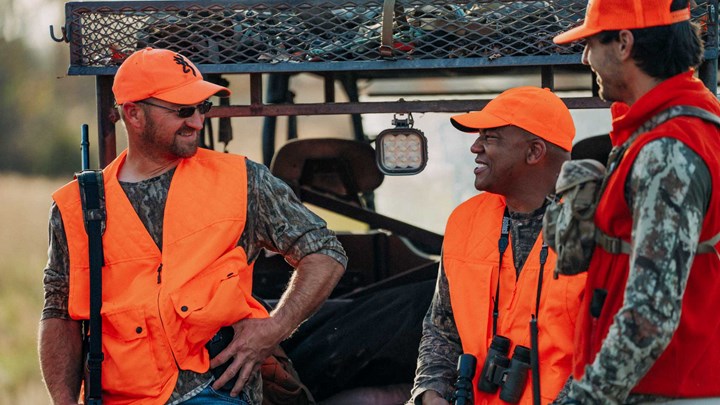
by Mark Chesnut - Wednesday, September 11, 2024

In my 25-plus years of reporting on bogus, inherently-biased anti-gun studies meant to turn the public, via the so-called “mainstream” media, against private firearm ownership, I’ve never seen one quite as laughable as a recent piece of “research” led by Princeton University and posted online by the Journal of the American Medical Association.
While the so-called “study” is obviously designed to tell the “dangers” of civilian gun ownership and guns in public, it comes up with a brand new, and very surprising, villain—American deer hunters in rural areas.
The “study” is called “Deer Hunting Season and Firearm Violence in U.S. Rural Counties.” Report authors Patrick Sharkey, affiliated with the Princeton University School of Public and International Affairs; Juan Camilo Cristancho with the University of California, Irvine School of Education; and Daniel Semenzalk with the New Jersey Gun Violence Research Center at Rutgers University, set out to determine the association between the start of deer season and criminal shootings in rural counties.
“Sharkey’s study is a twofer for the gun ban industry,” wrote Lee William at thetruthabotguns.com. “It manages to denigrate both hunting and gun ownership.”
Why anyone even would have started with such a bone-headed premise in the first place is truly unfathomable. But, of course, the authors managed to “find” just what they were looking for.
“This study suggests that the start of deer hunting season is associated with a substantial increase in shootings, highlighting the role of firearm prevalence in gun violence,” the “researchers” concluded.
What the “study” is meant to do is to build on the proven fallacy that more guns in public make everyone less safe, when, in fact, it is only guns in the hands of criminals that make society less safe.
“Firearm violence is a major public health problem in the U.S.,” the abstract states. “However, relatively little research has focused particular attention on firearm violence in rural areas, and few studies have used research designs that draw on exogenous variation in the prevalence of firearms to estimate the association between firearm presence and shootings.”
To make this link, “researchers” chose to look at the first three weeks of deer season, with the idea that with hundreds of thousands of deer hunters in the woods, there would obviously be more guns in public—never mind the fact that the deer woods isn’t exactly a public place. So, the junk “scientists” set out to look at the rate of “shootings” in rural counties during the first three weeks of deer season.
Through various ineptitudes and lack of diligence by the “researchers,” the “study” finally looked at a sample of 854 rural counties in 44 states. (In some counties and states it apparently was just too difficult to do the hard work necessary to determine when deer seasons started.) The “researchers” then chose to introduce even more bias and lies into the project by using “data” from the many-times discredited Gun Violence Archive (GVA), which even some anti-gun groups have chosen to shun.
The results, not surprisingly, shined a bad light on deer hunters, gun owners and private firearm ownership overall. While so-called “gun violence” increased substantially in rural counties during the first few weeks of deer season, the conclusion got down to the nuts and bolts of what the “researchers” wanted to “prove” from the beginning.
“Our findings align with a body of research showing that firearm prevalence is associated with an increase in the risk of firearm violence,” the report stated. “Although our findings do not address state or federal policy, research showing that state-level firearm regulations reduce shootings is relevant to discussions of how states might respond.”
Of course, the “mainstream” media lapped it up, with U.S. News & World Report, Forbes, NBC News and CBS all publishing a rehash of the “study.” The “study” also appeared on the National Institute of Health’s website, along with being printed and posted online in many newspapers and websites for various news groups throughout the country.
Google’s AI Overview even made gushing claims about the “study.”
“A 2024 study by Princeton University sociology professor Patrick Sharkey found that gun violence in rural America increases during deer hunting season,” the overview gushed. “The study found that firearm shootings increase by 49% in the week after the season begins, and remain 41% higher in the second week.”
In the end, this “study” was nothing more than a ridiculous waste of money and time. It did not prove that any of the increased shootings were committed by deer hunters or even had anything to do with deer hunters or deer season. It did not “find a linear association between hunting licenses per capita and shootings.” Plus, “The start of deer hunting season was associated with null effects on overall crime, as well as a reduction in alcohol-related arrest,” according to police data.
In fact, since the first three weeks of deer season likely encompasses Thanksgiving weekend in the vast majority of those counties, it would be just as easy to conclude that shootings go up in rural counties around the Thanksgiving holidays. At least that’s something else to blame it on, even though there is no proof that Thanksgiving actually causes an increase in violent crime—just like deer hunting doesn’t.
Alas, the “researchers” practically admitted that the “study” proves absolutely nothing important in the fine print at the conclusion.
“The study was determined to be exempt from review by Princeton University’s institutional review board because it is not human participants research,” the report said.
E-mail your comments/questions about this site to:
[email protected]
Proudly supported by The NRA Foundation and Friends of NRA fundraising.
